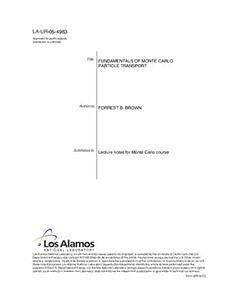Table Of ContentLA-UR-05-4983
Approved for public release;
distribution is unlimited.
Title:
FUNDAMENTALS OF MONTE CARLO
PARTICLE TRANSPORT
Author(s):
FORREST B. BROWN
Submitted to:
Lecture notes for Monte Carlo course
Los Alamos National Laboratory, an affirmative action/equal opportunity employer, is operated by the University of California for the U.S.
Department of Energy under contract W-7405-ENG-36. By acceptance of this article, the publisher recognizes that the U.S. Government
retains a nonexclusive, royalty-free license to publish or reproduce the published form of this contribution, or to allow others to do so, for U.S.
Government purposes. Los Alamos National Laboratory requests that the publisher identify this article as work performed under the
auspices of the U.S. Department of Energy. Los Alamos National Laboratory strongly supports academic freedom and a researcher’s right to
publish; as an institution, however, the Laboratory does not endorse the viewpoint of a publication or guarantee its technical correctness.
Form 836 (8/00)
Fundamentals of Monte Carlo Particle Transport
Lecture 1
FFuunnddaammeennttaallss
ooff MMoonnttee CCaarrlloo
PPaarrttiiccllee TTrraannssppoorrtt
Forrest B. Brown
Monte Carlo Group (X-3)
Los Alamos National Laboratory
1 -1 LA-UR-04–8817
Abstract
Fundamentals of Monte Carlo Particle Transport
Solving particle transport problems with the Monte Carlo method is simple -
just simulate the particle behavior. The devil is in the details, however. This
course provides a balanced approach to the theory and practice of Monte
Carlo simulation codes, with lectures on transport, random number
generation, random sampling, computational geometry, collision physics,
tallies, statistics, eigenvalue calculations, variance reduction, and parallel
algorithms. This is not a course in how to use MCNP or any other code, but
rather provides in-depth coverage of the fundamental methods used in all
modern Monte Carlo particle transport codes. The course content is suitable
for beginners and code users, and includes much advanced material of
interest to code developers. (10 lectures, 2 hrs each)
The instructor is Forrest B. Brown from the X-5 Monte Carlo team. He has 25 years experience in
developing production Monte Carlo codes at DOE laboratories and over 200 technical publications on
Monte Carlo methods and high-performance computing. He is the author of the RACER code used by the
DOE Naval Reactors labs for reactor design, developed a modern parallel version of VIM at ANL, and is a
lead developer for MCNP5, MCNP6, and other Monte Carlo codes at LANL.
1 -2 LA-UR-04–8817
Topics
1. Introduction
– Monte Carlo & the Transport Equation
– Monte Carlo & Simulation
2. Random Number Generation
3. Random Sampling
4. Computational Geometry
5. Collision Physics
6. Tallies & Statistics
7. Eigenvalue Calculations – Part I
8. Eigenvalue Calculations – Part II
9. Variance Reduction
10.Parallel Monte Carlo
11.References
1 -3 LA-UR-04–8817
Introduction
• Von Neumann invented scientific computing in the 1940s
– Stored programs, "software"
– Algorithms & flowcharts
– Assisted with hardware design as well
– "Ordinary" computers today are called "Von Neumann machines"
• Von Neumann invented Monte Carlo methods for particle transport in
the 1940s (with Ulam, Fermi, Metropolis, & others at LANL)
– Highly accurate – no essential approximations
– Expensive – typically the "method of last resort"
– Monte Carlo codes for particle transport have been proven to work
effectively on all types of computer architectures:
SIMD, MIMD, vector, parallel, supercomputers,
workstations, PCs, Linux clusters, clusters of anything,…
1 -4 LA-UR-04–8817
Introduction
• Two basic ways to approach the use of Monte Carlo methods for
solving the transport equation:
– Mathematical technique for numerical integration
– Computer simulation of a physical process
(cid:2) Each is "correct"
(cid:1) Mathematical approach is useful for:
Importance sampling, convergence, variance reduction,
random sampling techniques, eigenvalue calculation schemes, …..
(cid:1) Simulation approach is useful for:
collision physics, tracking, tallying, …..
• Monte Carlo methods solve integral problems, so consider the integral
form of the Boltzmann equation
• Most theory on Monte Carlo deals with fixed-source problems.
Eigenvalue problems are needed for criticality and reactor physics
calculations.
1 -5 LA-UR-04–8817
Introduction
Simple Monte Carlo Example
1
Evaluate G = (cid:2) g(x)dx, with g(x) = 1(cid:1) x2 g(x)
0
x
• Mathematical approach:
xˆ
For k = 1, …, N: choose randomly in (0,1)
k
N N
G= (1(cid:1) 0)(cid:3)[average value of g(x)] (cid:2) 1 (cid:3)(cid:4)g(xˆ ) = 1 (cid:3)(cid:4) 1(cid:1) x2
N k N k
k=1 k=1
• Simulation approach:
1
+ miss
"darts game"
y
For k = 1, …, N: choose x ˆ , (cid:1) y ˆ randomly in (0,1),
k k + hit
i f (cid:1) (cid:1) (cid:1) (cid:1) xˆ 2 + yˆ 2 (cid:1)(cid:1) (cid:1) (cid:1)1 , tally a "hit"
0
k k
0 x 1
number of hits
(cid:1)(cid:1)(cid:1)(cid:1)(1(cid:2)1)(cid:2)
G = [area under curve]
N
1 -6 LA-UR-04–8817
Introduction
Monte Carlo is often the method-of-choice for applications
with integration over many dimensions
Examples: high-energy physics, particle transport,
financial analysis, risk analysis, process engineering, …..
1 -7 LA-UR-04–8817
Introduction – Probability Density Functions
• Continuous Probability Density
f(x) = probability density function (PDF)
f(x) (cid:3) 0
b
Probability{a (cid:1) x (cid:1) b} = (cid:4) f(x)dx
a
(cid:2)
Normalization: (cid:4) f(x)dx = 1
-(cid:2)
• Discrete Probability Density
{ f }, k = 1,...,N, where f = f(x )
k k k
f (cid:1) 0
k
Probability{ x = x } = f
k k
N
Normalization: (cid:2)f = 1
k
k=1
1 -8 LA-UR-04–8817
Introduction – Basic Statistics
1 -9 LA-UR-04–8817

